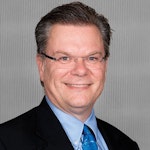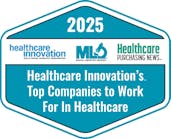ORLANDO – Attendance at the annual conference of the Association for Health Care Resource & Materials Management (AHRMM) continues to rebound in pursuit of returning to the growing momentum that existed prior to the onset of the global COVID-19 pandemic in January 2020.
Because of the pandemic and resulting business travel restrictions, AHRMM20, originally scheduled for late July in Austin, transitioned to an all-virtual event with dual broadcasts in late September and early October, respectively. AHRMM’s decision, motivated by its concern for the health and safety of its attendees and industry, announced the decision in late May, amid similar decisions by a growing number of conferences and trade shows that year as educational sessions and exhibitions throughout the healthcare industry and beyond all moved online only.
During the pandemic’s second year, AHRMM21 returned to a live event in late August in Nashville, attracting about a third of the attendance it recorded in 2019. AHRMM22 in early August attracted about half of the pre-pandemic crowd, and earlier this week here AHRMM23 seemed to draw about three-quarters of the attendance in 2019.
Even though the government declared the pandemic over three months ago, business travel still hasn’t returned to pre-pandemic levels as healthcare organizations continue to place restrictions on staffers, primarily due to budgets, service demands and staffing issues.
Just in case you were unable to attend the event live and in person, here are some observations you may have missed. (Don’t worry, AHRMM plans to share educational sessions virtually in September.)
New blood: Attendance may be eking back up but here’s something hopeful and thought-provoking about the future – estimates have been circulating that roughly 25% of attendees were first timers. Further, following the trend of the previous two pandemic years, the sessions focusing on the younger supply chain leaders and managers were packed, passionate and brimming with pride. Can anyone say, AHRRM: The Next Generation will represent a positive and noteworthy shift? We knew you could.
Post-pandemic push: Yeah, apparently, it’s over. But Supply Chain still is talking about it and trying to plan for any future recurrences or something even worse. As well it should. Supply Chain not only fuels the economy, but healthcare and our lifestyles. Some may roll their eyes if they hear the word “resilient” one more time, but at the very least, everyone understands that the current and future supply chain must be flexible and prepared to avert stockouts, backorders and overall manufacturing, distribution, logistics and transportation problems. And don’t forget about labor.
If you read some of our recent articles, Supply Chain related or not, most individuals we speak to will never forget the lessons they learned from COVID. It seems like, at AHRMM, and in general, industry professionals learned a big lesson about being proactive vs. reactive.
Data standards renaissance: There was renewed interest in the FDA’s Unique Device Identification (UDI) standards, which have been debated, dissected, explored and promoted for more than a decade. Attendees recognized the importance of tracking and tracing products for safety and fiscal propriety (yay!) and the valuable information located in the FDA GUDID database. Then questions emerged about how to gain access to the GUDID database and how to spell GUDID? Rest assured, all you advocates, ambassadors and evangelists for data standards. You’ve done an admirable job in your quest to educate and inform the industry for at least the last decade. This just means your mission continues. Refer to the first point above for the potential reason why.Show swag: The clinically oriented shows like AORN enjoy giving out such bling as Barbies in scrubs (kudos to Medline), but that’s not necessarily a draw for an operationally oriented show (foam models of Oppenheimer’s bomb likely wouldn’t work this year). Still, it can be challenging to outshine HealthTrust’s “S’more-kit-in-a-can” from AHRMM21 in Nashville. Several companies here leaned toward utility. HPN gives props to its booth neighbor Johnson & Johnson, which gave out baby/toddler packs containing “no-sting” shampoos, lotions and creams. Not to be outdone, Medegen passed out branded mesh bags to use for the beach, for the laundry or more prominently and proximately, for all the swag collected at the show!
How comforting it is to see the continued distribution of booth swag here even as the clinical and scientific shows have increasingly reduced it due to regulations against perceived undue influence. Bottom line: For attendees, trade shows are as much about seeing new products and services as they are about reconnecting with old friends and collecting new pens. And candy. And designer beverages. And foam gavels (shout-out to you, Centurion Service). And hand sanitizer.
Booth activity draw: Give it up for Oracle right near the exhibition entrance as they operated a Formula 1 simulator that allowed attendees to drive around the Circuit of the Americas track in Texas. Those amateur racers who achieved top times earned extra-special swag and were able to pose with a checkered flag.
Creative swag distribution: Few exhibitors like to return home with all the swag they brought to give out during the show to those who visit the booth and talk to reps – particularly if there’s so much that they have to pay to ship it back to headquarters. Workday, however, would have none of that. As crowds gathered at the AHRMM booth, which was diagonally from Workday’s booth, and AHRMM was giving away prizes at the show’s close, Workday reps formed a queue and started passing out excess swag to passersby, rubberneckers and those needing doodads to take home to the kids.
Frequent overheard conversational topic: “What’s up with A.I., huh?”
Artificial Intelligence (A.I.) appeared, or at least seemed to appear, at every other booth on the floor. With the buzz around ChatGPT, it wasn’t that surprising. There have been numerous articles recently about the reliability of this “hot” tech, including an August 8 press release, that shared the information that U.S. Sen. Mark R. Warner (D-VA), Chairman of the Senate Select Committee on Intelligence, penned a letter to Google CEO Sundar Pichai urging him to provide further clarity into his company’s deployment of Med-PaLM 2, an artificial intelligence (AI) chatbot that is currently being tested in healthcare settings. Sen. Warner’s letter expressed his concerns about reports of inaccuracies in the technology and asked Google to increase transparency, protect patient privacy and uphold ethical guardrails.
Ethics aside, the buzz on A.I. is certainly here to stay. So much so, that HPN is planning a virtual A.I. day. Stay tuned and continue checking out our website for more details.Most popular educational session: Hands down, this only can be the one with the best title (and don’t we all know that those with the coolest titles may not have the content or speakers to match), which was Monday morning’s “Jerks at Work: Engage Team Members That Think They Know Everything!” With all the cheering, shouting, laughing and applause, you’d think they were recreating the food fight scene in “Animal House” or talking about working with physicians! But that session was three rooms to the right. Simply put, the Stanford Health Care speaking duo really killed it. How do we know? It was a challenge to pay attention to presenters in a session next door!
Nonacute not subacute: The session titled “Non-Acute Care Settings Don’t Mean Sub-Acute Supply Chain” should resonate with most supply chain professionals as HPN knows from its annual compensation surveys that the majority of supply chain leaders and managers are responsible – and accountable – for supply chain service to nonacute care facilities. And those service levels are expected to be of comparable quality to what’s delivered to the acute care hospital(s). One comment during this session pinpointed one of the keys to success: “Data is the DNA of Supply Chain.” Another: “Everything we do in Supply Chain revolves around data.” These referenced the organization’s item master syncing up with the vendor’s version for the coveted “single source of truth.” Add in the chargemaster (CDM for charge data master) and the use of supply data standards and you have a recipe for effective and efficient demand and supply chain planning to identify actual transactions, identify and potentially reduce “rogue” or “shadow” spending. One further caveat: Nonacute care facilities at least should have a dedicated supply chain staffer (FTE) devoted to supply chain issues rather than dumping the function on a clinician that already has more patient-direct responsibilities for which to account. This needs to be endorsed and emphasized by senior leadership, too.Docs boxed: Depending on the organization, doctors and surgeons either get everything they want all the time or some of the time or they have to toe the corporate product contracting line all the time or some of the time. For many facilities, this represents a struggle between the C-suite (e.g., CEO, CFO, etc.) and the clinical suite with Supply Chain caught and stretched in the middle. For one supply chain leader and session speaker neither matter. Why? Through performance and perseverance, he developed a trusting professional relationship with the CEO, an alpha personality who is the organization founder and a practicing physician, which helped reinforce the product standardization efforts of the facility. While employed physicians are required to use contracted products regardless of preference, privileged physicians technically can use what they want. The caveat? The CEO mandates that whenever the physicians use their preferred products over what is under contract those physicians are charged the difference in price for those non-contracted products. Still, the supply chain leader acknowledged he didn’t always win these battles, but never made it personal and routinely emphasized the discussion centered on value to the organizations and patients.
Prescient process: One supply chain enterprise leader, thrust into an executive role just as the pandemic hit, shared her detailed process for encouraging office-based and remote staffers while maintaining cohesive bonds and routine interactions among the entire team. She used a rather simple organizational scheme to ensure success, based largely on her experience managing family activities. One key takeaway: When the next crisis hits – be it another respiratory viral pandemic or something else – this organization will be operating as business-as-usual while trying to answer calls for help from others who wasted the crisis COVID-19 brought to re-organize operations for a rainy day – make that a torrential deluge.
Biggest need: Cooling stations or portable face fans you can attach to your badge or lanyard. Maybe some company will sponsor it in the future? The Orlando Convention Center may be planted between two big hotels, connected by exterior overhead walkways, but the transition between the AC in the hotel to the AC in the Convention Center meant walking through a blanket of heat and humidity in the upper 90s with a heat index at least 10 degrees warmer. No, you couldn’t cook breakfast on the sidewalk like you could in Phoenix, but you did need to wring out your wardrobe and take another shower after the five-minute walk. No worries, for next year, Columbus in late September should offer some climate relief. The only red you’ll see are Ohio State fans during football season and what’s on our faces if we can’t find available hotel rooms should Michigan be playing there that weekend. After checking the 2024 OSU schedule, however, we found the Marshall Thundering Herd will be playing that weekend. Heave a sigh of relief now.CSC expanse: So much goes into setting up an off-site centralized/consolidated service center as comprehensive planning and decision-making extends beyond receiving bulk, breaking bulk and distributing to organizational facilities – whether owned and/or contracted. Many of the current CSCs in operation may not be revenue-generating enterprises (as in performing distribution and logistics services for other facilities outside your network or system) aside from third-party reprocessing or kit-and-pack operations. But it’s extremely important not only how you set up your CSC, but where in terms of location, according to speakers at one session. That’s where community relations come into play with Supply Chain as the healthcare face to a CSC business nearby. A CSC may provide jobs for the local residents, but transportation frequency and volume can disrupt, if not impact, local traffic patterns as well as affect roads not equipped to support heavy semi-tractors with trailers. But if you can site the CSC near railroad tracks servicing freight and passenger trains, provide a small station or stop with ample “free” parking and available office space in the building for CSC and hospital staffers as well as for suburban workers heading into the big city, that can be promoted as a win-win all around.
Balancing scales: During a session that explored developing future supply chain leaders, one speaker tried to poke a hole in the stereotype that the profession is all about products. “At the end of the day, we’re in the people business,” she emphasized to a wave of nodding heads. One of the main reasons staffers remain in supply chain within their respective organizations is the interpersonal relationships they have and continue to develop and grow under a strategy of “structured autonomy” where you trust their activities so long as their intentions focus on what’s good for the patient, what’s good for their fellow team members and what’s good for the organization to serve the community. This applies to everyone, no matter when and where you are in your career or from which industry you came – particularly if outside of healthcare, the speaker insisted. Recognize your abilities and capabilities, what value you bring to the organization, the team and the patients and realize that you were chosen by someone for a reason. You likely may not have all the answers, but you should stretch yourself and know how and where to get them – and from whom. Bottom line: Find and embrace three positive things about yourself that you carry with you and exude every day.
Eyebrow raiser: At non-healthcare industry shows a few months earlier, robots in the form of automated guided vehicles (AGVs) and autonomous mobile robots (AMRs) were all the rage (before A.I., of course), but the only working robot AHRMM attendees saw was the roving robosecurity character while the human security personnel just stood around. That just might signify one of the lasting outcomes from A.I.Making history: In HPN’s booth you could see the Lee Ayers, senior director, Supply Chain Operations, Sutter Health, the leader of the 2022 Supply Chain Department of the Year, pose for a grip-and-grin as he congratulates his award-winning successor, Eric Tritch, vice president, Supply Chain & Support Services, UChicago Medicine, at the 2023 Supply Chain Department of the Year. That’s Ayers on the left and Tritch on the right.
Mark your calendars now: AHRMM24 takes place more than a month later in the year, September 22-25, in Columbus, OH.
What do you think? Let us know by emailing [email protected].

Rick Dana Barlow | Senior Editor
Rick Dana Barlow is Senior Editor for Healthcare Purchasing News, an Endeavor Business Media publication. He can be reached at [email protected].










